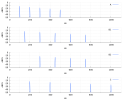Cars-N-Cans
Addicted to Fun and Learning
And this is why doing the “missing fundamental” test at high frequencies is a fool‘s errand. There are no musical notes that practically correspond to extremely high frequencies, only the harmonics. That means that any missing fundamental test will be restricted in how high up it can be. Can’t use 15 kHz, or even 10 kHz as the fundamental since it’s so shrill. My approach to ”how high” was to use a sine and a square wave with the same fundamental energy. Once the two sound indistinguishable, which was around 7 kHz for me, then all the harmonics are outside of human hearing. I think that or something similar is a better way to test whether ultrasonics are audible.


